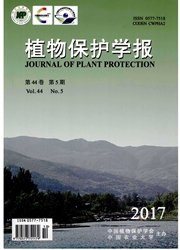

 中文摘要:
中文摘要:
以抗药性突变菌株为筛选标记,采用稀释倒平板法,研究了内生细菌EBS05在小麦体内的定殖动态,并通过盆栽和大田试验研究了EBS05对小麦纹枯病的防治效果。结果表明,EBS05在小麦根内具有较强的定殖能力,且能从根部向茎、叶部转移,其定殖量与菌株的接种浓度呈正相关,当接种浓度为108 CFU/mL时,EBS05能在根、茎内有效定殖,并持续向叶内转移。以菌体浓度为108CFU/mL的发酵液进行浸种或灌根处理后,EBS05在根内定殖量始终大于同时期茎、叶内的定殖量;菌株在小麦根、茎和叶内的定殖数量均表现为接种初期逐渐增加,至接种后第10~12天达到最大值,随后逐渐降低。内生细菌EBS05对小麦纹枯病的防治效果优于对照药剂25 g/L咯菌腈(flu-dioxonil)悬浮种衣剂,带菌发酵液和除菌发酵液的盆栽防治效果分别达91.2%和88.2%,大田防治效果分别为66.3%和56.2%。
 英文摘要:
英文摘要:
Colonization trends of endophytic bacteria EBS05 in wheat was assayed using the antibiotic resistant mutation strains as screening marker using the method of spread-plate technique,and its control effect on wheat sharp eyespot was investigated using pot culture and field test.The results showed that the endophytic bacteria EBS05 exhibited strong colonization capacity in wheat,and could move from root to stem and/or leaf.The colonization amount was in direct proportion to inoculation concentration,only which was more than 108 CFU/mL,the colonization and further transfer could effectively occurred.After treatment by soaking seed and drench with fermentation broth at 108 CFU/mL cell density,colonization amount of strain EBS05 in wheat root was more than that in stem and leaf at the same treatment time.The colonization amounts in root,stem and leaf increased gradually in the early stage of treatment,reached peaks at the tenth or twelfth day after treatment,and decreased gradually after that time.Application of the culture broth of endophytic bacteria EBS05 was proved to be more effective in controlling wheat sharp eyespot,compared with that of fungicide fludioxonil.The suppressive effects of fermentation broth and bacteria-free filter on the wheat sharp eyespot were up to 91.2% and 88.2% in the greenhouse,and 66.3% and 56.2% in the field,respectively.
 同期刊论文项目
同期刊论文项目
 同项目期刊论文
同项目期刊论文
 期刊信息
期刊信息
